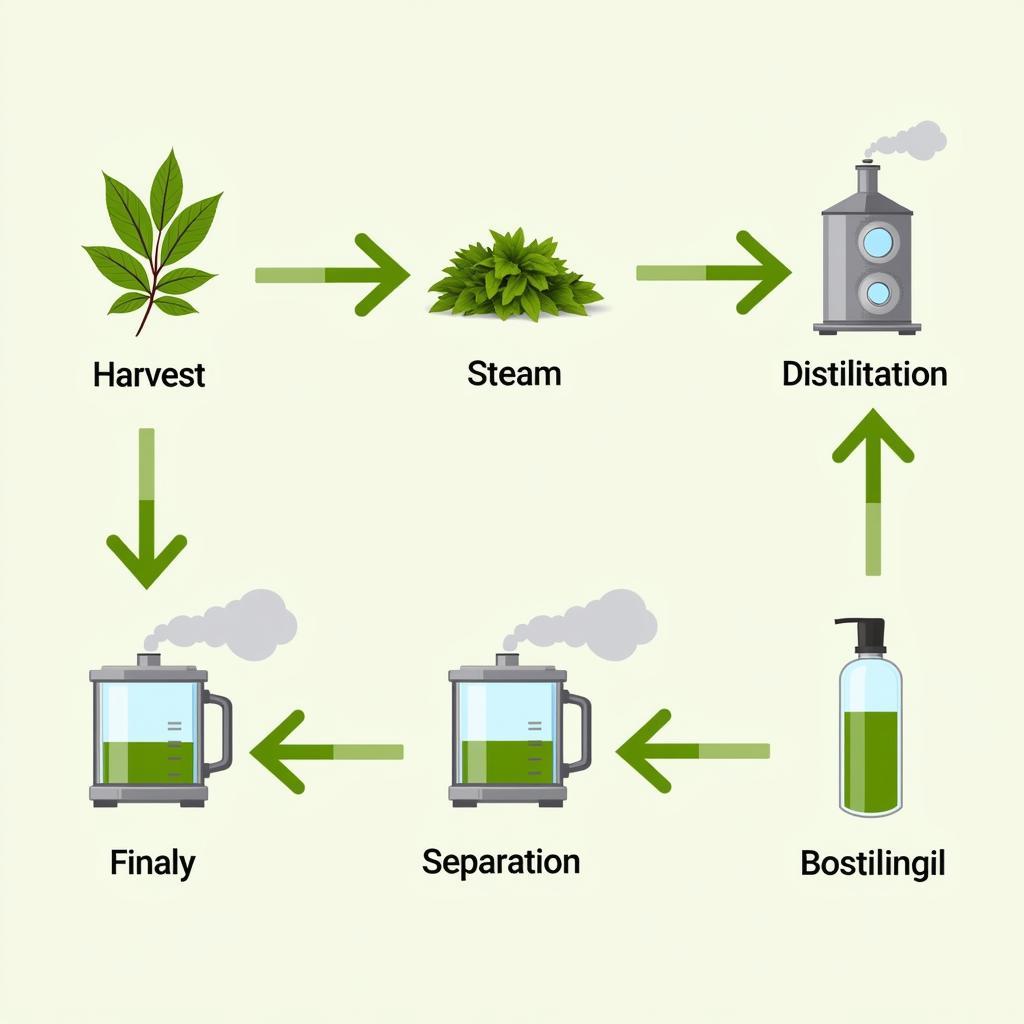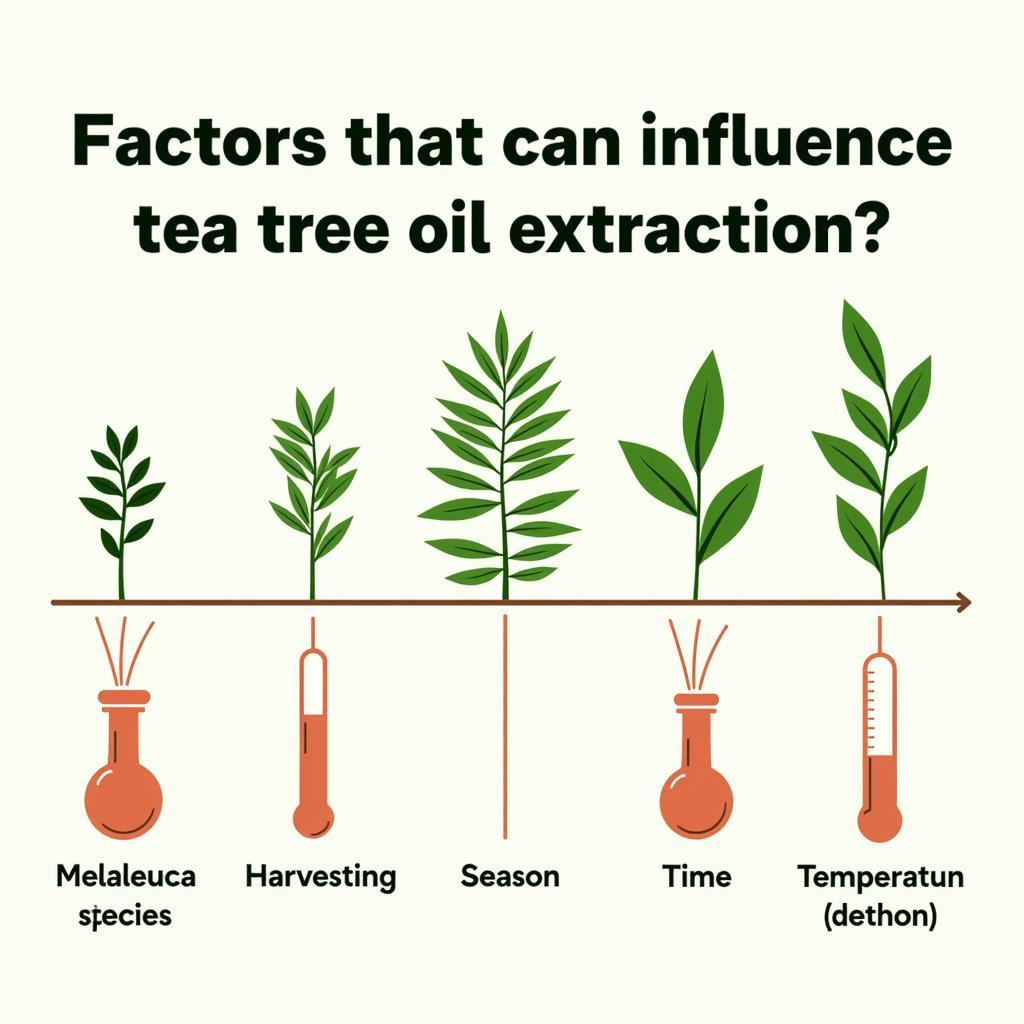Giỏ hàng hiện tại chưa có sản phẩm nào!

Understanding the Process of Tea Tree Oil Extraction (IELTS Listening)
The process of tea tree oil extraction is a common topic in IELTS Listening, often appearing in sections describing industrial processes or the origins of natural products. Understanding this process not only helps with IELTS but also provides insight into the production of this valuable essential oil.
How Tea Tree Oil is Extracted: A Step-by-Step Guide
Tea tree oil, renowned for its antiseptic properties, is derived from the leaves of the Melaleuca alternifolia tree, native to Australia. The extraction process, while seemingly complex, can be broken down into key stages. Let’s delve into each step:
- Harvesting: The leaves are harvested from mature tea trees, typically using mechanical harvesters. This ensures efficiency and consistency in the raw material.
- Drying (Optional): Some producers allow the leaves to dry slightly before processing, though this isn’t always necessary. This step can influence the final oil yield.
- Steam Distillation: This is the most common extraction method. Steam is passed through the leaves, releasing the essential oil. The steam carries the oil vapors into a condenser.
- Condensation: In the condenser, the steam and oil vapors cool and revert to liquid form. This mixture of water and oil is then collected.
- Separation: The essential oil, being less dense than water, floats on top. It is then carefully separated and collected.
- Filtering and Bottling: The extracted tea tree oil undergoes filtration to remove any remaining plant matter or impurities. Finally, it’s bottled and ready for distribution.
 Quá trình chiết xuất tinh dầu cây trà
Quá trình chiết xuất tinh dầu cây trà
Key Factors Affecting Tea Tree Oil Extraction
Several factors influence the quality and yield of tea tree oil. These include:
- Species of Tea Tree: While Melaleuca alternifolia is the primary source, other Melaleuca species can also produce oil, albeit with varying chemical compositions and properties.
- Harvesting Time: The time of year the leaves are harvested can affect the oil content and its chemical profile.
- Distillation Method: While steam distillation is the most common, other methods, like water distillation or solvent extraction, are sometimes used. Each method affects the final product.
- Distillation Time and Temperature: Precise control of these parameters is crucial for optimal oil extraction and quality.
 Các yếu tố ảnh hưởng đến quá trình chiết xuất tinh dầu cây trà
Các yếu tố ảnh hưởng đến quá trình chiết xuất tinh dầu cây trà
Tea Tree Oil and its Applications
Tea tree oil has a wide range of applications, thanks to its powerful antiseptic, antifungal, and anti-inflammatory properties. It’s commonly used in:
- Skincare: Treating acne, minor cuts, and insect bites.
- Household Cleaning: As a natural disinfectant and cleaning agent.
- Aromatherapy: For its refreshing and invigorating scent.
“The quality of tea tree oil is directly related to the meticulousness of the extraction process,” says Dr. Amelia Chen, a leading expert in botanical extracts. “Careful attention to each stage, from harvesting to bottling, ensures a potent and effective final product.”
The Process of Tea Tree Oil Extraction in IELTS Listening
In the IELTS Listening test, you might encounter descriptions of the tea tree oil extraction process. Be prepared for:
- Vocabulary related to the process: distillation, condensation, extraction, harvesting, separation, etc.
- Descriptions of the equipment used: boilers, condensers, separators.
- Information about the different stages: harvesting, drying, steam distillation, condensation, separation, filtering, bottling.
 Tinh dầu cây trà và ứng dụng của nó
Tinh dầu cây trà và ứng dụng của nó
“Understanding the key terms and steps involved will help you follow the listening passage and answer the questions accurately,” adds Dr. Chen. “Practice listening to descriptions of industrial processes to improve your comprehension.”
Conclusion: Mastering the Process for IELTS Success
Understanding the process of tea tree oil extraction is crucial not just for general knowledge but also for success in the IELTS Listening test. By familiarizing yourself with the steps, vocabulary, and factors involved, you’ll be well-equipped to handle any related questions. This knowledge, combined with regular practice, will undoubtedly boost your confidence and performance in the IELTS exam. Remember, the process of tea tree oil extraction can be a valuable topic for demonstrating your listening comprehension skills.
FAQ
- What is the most common method for extracting tea tree oil? (Steam distillation)
- What are some of the uses of tea tree oil? (Skincare, cleaning, aromatherapy)
- What is the scientific name of the tea tree? (Melaleuca alternifolia)
- What factors affect the quality of tea tree oil? (Species, harvesting time, distillation method)
- Why is understanding this process important for IELTS? (It’s a common topic in the Listening section)
- What are some keywords related to tea tree oil extraction? (Harvesting, distillation, condensation, separation)
- Where is the tea tree native to? (Australia)
Gợi ý các câu hỏi khác, bài viết khác có trong web:
- Các loại xe tải van phổ biến hiện nay
- Kinh nghiệm mua xe tải van cũ
- Thủ tục đăng ký xe tải van
- Các công việc lái xe tải van
Khi cần hỗ trợ hãy liên hệ Số Điện Thoại: 0372960696, Email: tuyet.sixt@gmail.com Hoặc đến địa chỉ: 260 Cầu Giấy, Hà Nội. Chúng tôi có đội ngũ chăm sóc khách hàng 24/7.